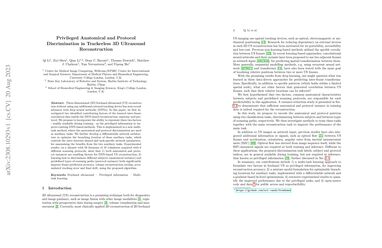Privileged Anatomical and Protocol Discrimination in Trackerless 3D Ultrasound Reconstruction
Three-dimensional (3D) freehand ultrasound (US) reconstruction without using any additional external tracking device has seen recent advances with deep neural networks (DNNs). In this paper, we first investigated two identified contributing factors of the learned inter-frame correlation that enable the DNN-based reconstruction: anatomy and protocol. We propose to incorporate the ability to represent these two factors - readily available during training - as the privileged information to improve existing DNN-based methods. This is implemented in a new multi-task method, where the anatomical and protocol discrimination are used as auxiliary tasks. We further develop a differentiable network architecture to optimise the branching location of these auxiliary tasks, which controls the ratio between shared and task-specific network parameters, for maximising the benefits from the two auxiliary tasks. Experimental results, on a dataset with 38 forearms of 19 volunteers acquired with 6 different scanning protocols, show that 1) both anatomical and protocol variances are enabling factors for DNN-based US reconstruction; 2) learning how to discriminate different subjects (anatomical variance) and predefined types of scanning paths (protocol variance) both significantly improve frame prediction accuracy, volume reconstruction overlap, accumulated tracking error and final drift, using the proposed algorithm.
PDF Abstract
